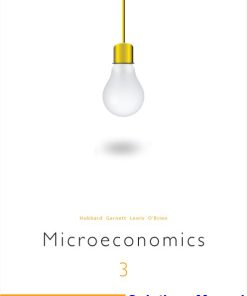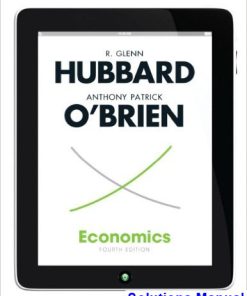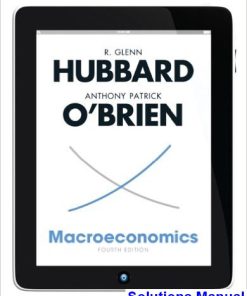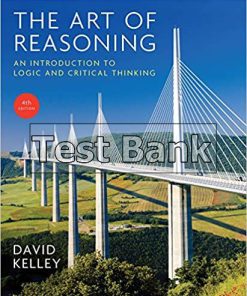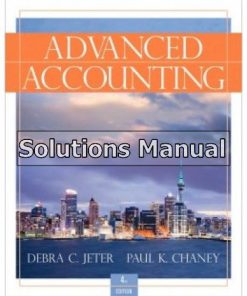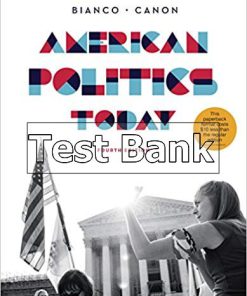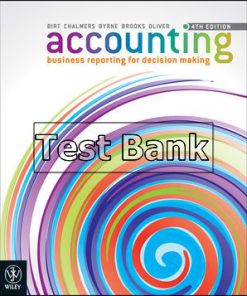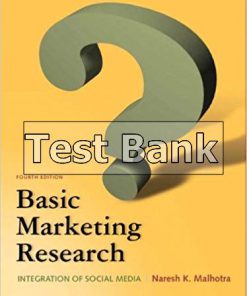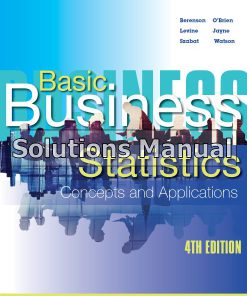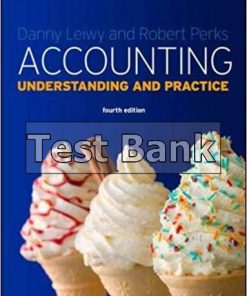Microeconomics 4th Edition Hubbard Solutions Manual
$50.00 Original price was: $50.00.$26.50Current price is: $26.50.
Microeconomics 4th Edition Hubbard Solutions Manual.
Microeconomics 4th Edition Hubbard Solutions Manual

Product details:
- ISBN-10 : 0132911981
- ISBN-13 : 978-0132911986
- Author: Hubbard/O’Brien
Hubbard/O’Brien explains the basics of economics by demonstrating how real businesses use economics to make real decisions everyday. This is something all readers can connect to, as they encounter businesses in their daily lives. And regardless of future career pathopening an art studio, doing social work, trading on Wall Street, working for the government, or bartending at the local pubreaders will benefit from understanding the economic forces behind their work.
Table contents:
- The foundation
- Special features
- Educator resources
- Reviewers
- Brief contents
- Detailed contents
- Flexibility chart
- Part 1 Introduction
- Chapter 1 Economics: Foundations and models
- Three key economic ideas
- People are rational
- People respond to economic incentives
- Optimal decisions are made at the margin
- Solved problem 1.1 Apple makes a decision at the margin
- Scarcity, trade-offs and the economic problem that every society must solve
- What goods and services will be produced?
- How will the goods and services be produced?
- Who will receive the goods and services produced?
- Centrally planned economies versus market economies
- The modern ‘mixed’ economy
- Efficiency and equity
- Economic models
- The role of assumptions in economic models
- Forming and testing hypotheses in economic models
- Normative and positive analysis
- Don’t let this happen to you
- Don’t confuse positive analysis with normative analysis
- Economics as a social science
- Making the connection 1.1
- Good economics doesn’t always mean good politics
- Microeconomics and macroeconomics
- Conclusion
- An inside look
- Robotics will hit finance jobs harder than offshoring
- Chapter summary and problems
- Chapter 1 Appendix
- Using graphs and formulas
- Graphs of one variable
- Graphs of two variables
- Formulas
- Appendix Questions and problems
- Chapter 2 Choices and trade-offs in the market
- Production possibility frontiers and real-world trade-offs
- Graphing the production possibility frontier
- Increasing marginal opportunity costs
- Making the connection 2.1
- Trade-offs and emergency aid relief
- Economic growth
- Comparative advantage and trade
- Specialisation and gains from trade
- Absolute advantage versus comparative advantage
- Don’t let this happen to you
- Don’t confuse absolute advantage with comparative advantage
- Comparative advantage and the gains from trade
- Solved problem 2.1 Comparative advantage and the gains from trade
- The market system
- The gains from free markets
- The market mechanism
- Making the connection 2.2
- Story of the market system in action: I, pencil
- The role of the entrepreneur
- The legal basis of a successful market system
- Protection of private property
- Making the connection 2.3
- Illegal downloads from cyberspace
- Enforcement of contracts and property rights
- Conclusion
- An inside look
- Expansion and production mix at BMW
- Chapter summary and problems
- Part 2 How the market works
- Chapter 3 Where prices come from: The interaction of demand and supply
- The demand side of the market
- Demand schedules and demand curves
- The law of demand
- Holding everything else constant: The ceteris paribus condition
- What explains the law of demand?
- Variables that shift market demand
- Making the connection 3.1
- The ageing of the Baby Boom generation
- A change in demand versus a change in quantity demanded
- The supply side of the market
- Supply schedules and supply curves
- The law of supply
- Variables that shift supply
- A change in supply versus a change in quantity supplied
- Market equilibrium: Putting demand and supply together
- How markets eliminate surpluses and shortages
- Demand and supply both count
- Shifts in a curve versus movements along a curve
- The effect of demand and supply shifts on equilibrium
- Don’t let this happen to you
- Remember: A change in a good’s price does not cause the demand or supply curve to shift
- The effect of shifts in supply on equilibrium
- The effect of shifts in demand on equilibrium
- The effect of shifts in demand and supply over time
- Solved problem 3.1 Demand and supply both count: Pharmacists and accountants
- Making the connection 3.2
- The rise and rise of fitness trackers
- Solved problem 3.2 Demand and supply both count: The Australian housing market
- Conclusion
- An inside look
- PC shipments fall record 10.6% in 4Q: IDC
- Chapter summary and problems
- Chapter 4 Elasticity: The responsiveness of demand and supply
- Price elasticity of demand and its measurement
- Measuring the price elasticity of demand
- Elastic demand and inelastic demand
- An example of calculating price elasticities
- The midpoint formula
- Solved problem 4.1 Calculating the price elasticity of demand for wheat using the midpoint formula
- When demand curves intersect, the flatter curve is more elastic
- Polar cases of perfectly elastic and perfectly inelastic demand
- Don’t let this happen to you
- Don’t confuse inelastic with perfectly inelastic
- The determinants of the price elasticity of demand
- Availability of close substitutes
- Length of time involved
- Making the connection 4.1
- The price elasticity of demand for breakfast cereal
- Luxuries versus necessities
- Solved problem 4.2 Using price elasticity to analyse the drug problem
- Definition of the market
- Share of the good in the consumer’s budget
- The relationship between price elasticity and total revenue
- Elasticity and revenue with a linear demand curve
- Solved problem 4.3 Price and revenue don’t always move in the same direction
- Estimating price elasticity of demand
- Other demand elasticities
- Cross-price elasticity of demand
- Income elasticity of demand
- Making the connection 4.2
- Using elasticity to analyse the disappearing family farm
- The price elasticity of supply and its measurement
- Measuring the price elasticity of supply
- Determinants of the price elasticity of supply
- Making the connection 4.3
- Why are oil prices so unstable?
- Polar cases of perfectly elastic and perfectly inelastic supply
- Using price elasticity of supply to predict changes in price
- Conclusion
- An inside look
- Cider poised to overtake alcopops, Roy Morgan Research
- Chapter summary and problems
- Chapter 5 Economic efficiency, government price setting and taxes
- Consumer surplus and producer surplus
- Consumer surplus
- Producer surplus
- Making the connection 5.1
- The consumer surplus from broadband Internet service
- What consumer surplus and producer surplus measure
- The efficiency of competitive markets
- Marginal benefit equals marginal cost in competitive equilibrium
- Economic surplus
- Deadweight loss
- Economic surplus and economic efficiency
- Government intervention in the market: Price floors and price ceilings
- Price floors: The example of agricultural markets
- Price ceilings: The example of rent controls
- Making the connection 5.2
- Price floors in labour markets: The minimum wage
- Black markets
- Don’t let this happen to you
- Don’t confuse scarcity with a shortage
- Solved problem 5.1 What is the economic effect of a black market for apartments?
- The results of government intervention: Winners, losers and inefficiency
- Positive and normative analysis of price ceilings and price floors
- The economic impact of taxes
- The effect of taxes on economic efficiency
- Tax incidence: Who actually pays a tax?
- Solved problem 5.2 When do consumers pay all of a sales tax increase?
- Conclusion
- An inside look
- Australian smokers to pay more than $45 for a packet of cigarettes from 2020
- Chapter summary and problems
- Chapter 5 Appendix
- Quantitative demand and supply analysis
- Demand and supply equations
- Calculating consumer surplus and producer surplus
- Appendix Questions and problems
- Part 3 Consumers and firms
- Chapter 6 Consumer choice and behavioural economics
- Utility and consumer decision making
- The economic model of consumer behaviour in a nutshell
- Utility
- The principle of diminishing marginal utility
- The rule of equal marginal utility per dollar spent
- Solved problem 6.1 Finding the optimal level of consumption
- What if the rule of equal marginal utility per dollar does not hold?
- Don’t let this happen to you
- Equalise marginal utilities per dollar
- The income effect and substitution effect of a price change
- Where demand curves come from
- Making the connection 6.1
- Are there any upward-sloping demand curves in the real world?
- Social influences on decision making
- The effects of celebrity endorsements
- Network externalities
- Does fairness matter?
- Making the connection 6.2
- Is Uber price gouging?
- Behavioural economics: Do people make their choices rationally?
- Pitfalls in decision making
- Ignoring non-monetary opportunity costs
- Business implications of consumers ignoring non-monetary opportunity costs
- Failing to ignore sunk costs
- Making the connection 6.3
- A blogger who understands the importance of ignoring sunk costs?
- Being unrealistic about future behaviour
- The behavioural economics of shopping
- Solved problem 6.2 How do you get people to save more of their income?
- Conclusion
- An inside look
- Celebrity endorsements
- Chapter summary and problems
- Chapter 6 Appendix
- Using indifference curves and budget lines to understand consumer behaviour
- Consumer preferences
- The budget constraint
- Making the connection 6A.1
- Dell determines the optimal mix of products
- Solved problem 6A.1 When does a price change make a consumer better off?
- Deriving the demand curve
- The slope of the indifference curve, the slope of the budget line and the rule of equal marginal uti
- Appendix Questions and problems
- Chapter 7 Technology, production and costs
- Technology: An economic definition
- The short run and the long run in economics
- The difference between fixed costs and variable costs
- Making the connection 7.1
- Improving inventory control at Bunnings
- Implicit costs versus explicit costs
- Making the connection 7.2
- Fixed costs in the publishing industry
- The production function
- A first look at the relationship between production and cost
- The marginal product of labour and the average product of labour
- The law of diminishing returns
- Making the connection 7.3
- Adam Smith’s famous account of the division of labour in a pin factory
- The relationship between marginal product and average product
- Graphing production
- The relationship between short-run production and short-run cost
- Marginal cost
- The relationship between marginal cost and average total cost
- Solved problem 7.1 The relationship between marginal cost and average total cost
- Graphing cost curves
- Costs in the long run
- Economies of scale
- Long-run average cost curves for bookshops
- Solved problem 7.2 Using long-run average cost curves to understand business strategy
- Making the connection 7.4
- The colossal River Rouge: Diseconomies of scale at the Ford Motor company
- Don’t let this happen to you
- Don’t confuse diminishing returns with diseconomies of scale
- Conclusion
- An inside look
- Can economies of scale rescue Tesla?
- Chapter summary and problems
- Chapter 7 Appendix
- Using isoquants and isocosts to understand production and cost
- Isoquants
- Isocost lines
- Choosing the cost-minimising combination of capital and labour
- Making the connection 7A.1
- The changing input mix in Walt Disney film animation
- Solved problem 7A.1 Determining the optimal combination of inputs
- The expansion path
- Appendix Questions and problems
- Part 4 Market structure and firm strategy
- Chapter 8 Firms in perfectly competitive markets
- Perfectly competitive markets
- A perfectly competitive firm cannot affect the market price
- The demand curve for the output of a perfectly competitive firm
- Don’t let this happen to you
- Don’t confuse the demand curve for Farmer Jones’ oats with the market demand curve for oats
- How a firm maximises profit in a perfectly competitive market
- Revenue for a firm in a perfectly competitive market
- Determining the profit-maximising level of output
- Illustrating profit or loss on the cost curve graph
- Showing profit on the graph
- Solved problem 8.1 Determining profit-maximising price and quantity
- Don’t let this happen to you
- Remember that firms maximise total profit, not profit per unit
- Illustrating when a firm is breaking even or operating at a loss
- Deciding whether to produce or to shut down in the short run
- Making the connection 8.1
- Losing money in the solar panel industry
- Solved problem 8.2 When to shut down an oil well
- The supply curve of the firm in the short run
- The market supply curve in a perfectly competitive industry
- ‘If everyone can do it, you can’t make money at it’—the entry and exit of firms in the long
- Economic profit and the entry or exit decision
- Long-run equilibrium in a perfectly competitive market
- The long-run supply curve in a perfectly competitive market
- Increasing-cost and decreasing-cost industries
- Making the connection 8.2
- In the App Store, easy entry makes the long run pretty short
- Perfect competition and efficiency
- Productive efficiency
- Allocative efficiency
- Dynamic efficiency
- Solved problem 8.3 How productive efficiency and dynamic efficiency benefit consumers
- Conclusion
- An inside look
- Why the sharing economy could have a hard landing in Australia
- Chapter summary and problems
- Chapter 9 Monopoly markets
- Is any firm ever really a monopoly?
- Where do monopolies come from?
- Making the connection 9.1
- Does Hasbro have a monopoly on Monopoly?
- Entry blocked by government action
- Control of a key resource
- Network externalities
- Making the connection 9.2
- Are diamond (profits) forever? The De Beers diamond monopoly
- Natural monopoly
- How does a monopoly choose price and output?
- Marginal revenue
- Profit maximisation for a monopolist
- Solved problem 9.1 Finding profit-maximising price and output for a monopolist
- Don’t let this happen to you
- Don’t assume that charging a higher price is always more profitable for a monopolist
- Does monopoly reduce economic efficiency?
- Comparing monopoly and perfect competition
- Measuring the efficiency losses from monopoly
- How large are the efficiency losses due to monopoly?
- Market power and technological change
- Government policy towards monopolies
- Trade practices laws and enforcement
- Mergers: The trade-off between market power and efficiency
- Making the connection 9.3
- Anti-competitive behaviour in the airline cargo industry
- Regulating natural monopolies
- Solved problem 9.2 Water restrictions and water supply companies
- Conclusion
- An inside look
- Footy fans stuck with Foxtel until 2022
- Chapter summary and problems
- Chapter 9 Appendix
- Price discrimination
- The requirements for successful price discrimination
- Solved problem 9A.1 How Dell technologies uses price discrimination to increase profits
- Airlines: The kings of price discrimination
- Perfect price discrimination
- Price discrimination across time
- Making the connection 9A.1
- The Internet leaves you open to price discrimination
- Appendix Questions and problems
- Chapter 10 Monopolistic competition: The competitive model in a more realistic setting
- Demand and marginal revenue for a firm in a monopolistically competitive market
- The demand curve for a monopolistically competitive firm
- Marginal revenue for a firm with a downward-sloping demand curve
- How a monopolistically competitive firm maximises profit in the short run
- Solved problem 10.1 How not to maximise profit
- What happens to profit in the long run?
- How does entry of new firms affect the profits of existing firms?
- Don’t let this happen to you
- Don’t confuse zero economic profit with zero accounting profit
- Making the connection 10.1
- The rise and decline and rise of Starbucks
- Is zero economic profit inevitable in the long run?
- Solved problem 10.2 Buffalo wild wings increase costs to increase demand
- Making the connection 10.2
- Staying one step ahead of the competition: Eugène Schueller and L’Oréal
- Comparing perfect competition and monopolistic competition
- Excess capacity under monopolistic competition
- Is monopolistic competition inefficient?
- How consumers benefit from monopolistic competition
- How marketing differentiates products
- Brand management
- Advertising
- Defending a brand name
- What makes a firm profitable?
- Making the connection 10.3
- Is being the first firm in the market a key to success?
- Conclusion
- An inside look
- Booming coffee market moves into consolidation phase
- Chapter summary and problems
- Chapter 11 Oligopoly: Markets with few competitors
- Oligopoly and barriers to entry
- Barriers to entry
- Game theory and oligopoly
- A duopoly game: Price competition between two firms
- Firm behaviour and the prisoners’ dilemma
- Don’t let this happen to you
- Don’t misunderstand why each manager ends up charging a price of $450
- Can firms escape the prisoners’ dilemma?
- Making the connection 11.1
- Is there a dominant strategy for bidding on eBay?
- Solved problem 11.1 Is advertising a prisoners’ dilemma for Coca-Cola and Pepsi?
- Cartels: The case of OPEC
- Sequential games
- Deterring entry
- Solved problem 11.2 Is deterring entry always a good idea?
- Bargaining
- The five competitive forces model
- Competition from existing firms
- The threat from potential entrants
- Competition from substitute goods or services
- Bargaining power of buyers
- Bargaining power of suppliers
- Making the connection 11.2
- Is Virgin Australia’s business strategy more important than the structure of the airline industry?
- Conclusion
- An inside look
- Supermarket giant ALDI gears up for price war
- Chapter summary and problems
- Chapter 11 Appendix
- Traditional models of oligopoly
- ‘Sticky’ prices and the kinked demand curve
- Bertrand model
- Cournot model
- Stackelberg model
- Part 5 Markets for factors of production
- Chapter 12 The markets for labour and other factors of production
- The demand for labour
- The marginal revenue product of labour
- Solved problem 12.1 Hiring decisions by a firm that is a price maker
- The market demand curve for labour and the factors that shift it
- The supply of labour
- The market supply curve of labour and the factors that shift it
- Equilibrium in the labour market
- The effect on equilibrium wages of a shift in labour demand
- Making the connection 12.1
- Will your future income depend on which courses you take at university?
- The effect on equilibrium wages of a shift in labour supply
- Making the connection 12.2
- Should you fear the effect of robots on the labour market?
- Explaining differences in wages
- Don’t let this happen to you
- Remember that prices and wages are determined at the margin
- Making the connection 12.3
- Technology and the earnings of ‘superstars’
- Compensating differentials
- Discrimination
- Trade unions
- Solved problem 12.2 Is ‘comparable worth’ legislation the answer to closing the gap between men
- Personnel economics
- Should workers’ pay depend on how much they work or on how much they produce?
- Other considerations in setting compensation schemes
- The markets for capital and natural resources
- The market for capital
- Solved problem 12.3 How to receive your payments
- The market for natural resources
- Monopsony
- The marginal productivity theory of income distribution
- Conclusion
- An inside look
- Watson, Marsh go big in IPL auction
- Chapter summary and problems
- Part 6 The international economy
- Chapter 13 Comparative advantage and the gains from international trade
- An overview of international trade
- The importance of trade to the Australian economy
- Australian international trade in a world context
- Making the connection 13.1
- Has offshoring hurt the Australian economy?
- Comparative advantage in international trade
- A brief review of comparative advantage
- Comparative advantage and absolute advantage
- How countries gain from international trade
- Increasing consumption through trade
- Solved problem 13.1 The gains from trade
- Why don’t we see complete specialisation?
- Does anyone lose as a result of international trade?
- Don’t let this happen to you
- Remember that trade creates both winners and losers
- Where does comparative advantage come from?
- Government policies that restrict international trade
- Tariffs
- Quotas
- Measuring the economic impact of the sugar quota
- Solved problem 13.2 Measuring the economic effect of a quota
- Gains from unilateral elimination of tariffs and quotas
- Domestic support policies
- Other barriers to trade
- The arguments over trade policies and globalisation
- Why do some people oppose the World Trade Organization?
- Dumping
- Making the connection 13.2
- The unintended consequences of banning goods made with child labour
- Radical environmentalism
- Positive versus normative analysis (once again)
- Conclusion
- An inside look
- Australia’s long-awaited free trade deal with China finally comes into force
- Chapter summary and problems
- Part 7 The role of government
- Chapter 14 Government intervention in the market
- What’s good about markets?
- The economic bases for government intervention
- Making the connection 14.1
- Should drugs be legal?
- Market failure and government failure
- Don’t let this happen to you
- Just because something is wrong, it doesn’t mean the government has to put it right
- Deregulation and privatisation
- The legal system
- The rule of law
- Patents, trademarks and copyright protection
- Making the connection 14.2
- Who owns the Wizard of Oz?
- Asymmetric information
- Adverse selection and the market for ‘lemons’
- Reducing adverse selection in the car market
- Asymmetric information in the market for insurance
- Reducing adverse selection in the insurance market
- Moral hazard
- Don’t let this happen to you
- Don’t confuse adverse selection with moral hazard
- Making the connection 14.3
- Why is the cost of health care rising in Australia?
- Adverse selection and moral hazard in financial markets
- Solved problem 14.1 Do minimum wages increase adverse selection and moral hazard?
- Reducing adverse selection and moral hazard in financial markets
- Conclusion
- An inside look
- Keeping up or holding back? The regulation challenge for government
- Chapter summary and problems
- Chapter 15 Externalities, environmental policy and public goods
- Externalities and efficiency
- The effect of externalities
- How externalities in production reduce economic efficiency
- How externalities in consumption reduce economic efficiency
- Externalities and market failure
- What causes externalities?
- Private solutions to externalities: The Coase theorem
- The economically efficient level of pollution reduction
- Making the connection 15.1
- The reduction in lead in Melbourne’s air
- Don’t let this happen to you
- Remember that it’s the net benefit that counts
- The basis for private solutions to externalities
- Do property rights matter?
- The problem of transactions costs
- The Coase theorem
- Making the connection 15.2
- The fable of the bees
- Government policies to deal with externalities
- Policies for externalities in production
- Policies for externalities in consumption
- Command and control and market-based approaches
- Making the connection 15.3
- Should the government tax soft drinks?
- Solved problem 15.1 Using a tax to deal with a negative externality
- Licences to pollute?
- Making the connection 15.4
- Can a price on carbon reduce global warming?
- Four categories of goods
- The demand for a public good
- Common resources
- Conclusion
- An inside look
- Too big to fail: China pledges to set up landmark emissions trading scheme
- Chapter summary and problems
- Chapter 16 The distribution of income and social policy
- The tax system
- An overview of the Australian tax system
- Progressive and regressive taxes
- Making the connection 16.1
- Which groups pay the most in taxes?
- Marginal and average income tax rates
- Evaluating taxes
- Tax incidence revisited: The effect of price elasticity
- Don’t let this happen to you
- Remember not to confuse who pays the tax with who bears the burden of the tax
- Making the connection 16.2
- Do companies really bear the burden of the federal company income tax?
- Solved problem 16.1 The effect of price elasticity on the excess burden of a tax
- Income distribution and poverty
- Measuring the distribution of income and poverty
- The poverty rate in Australia
- Explaining income inequality
- Showing the income distribution with a Lorenz curve
- Problems in measuring poverty and the distribution of income
- Solved problem 16.2 Are many individuals stuck in poverty?
- Income distribution and poverty around the world
- Conclusion
- An inside look
- 3.6 million households pay no net tax after churn
- Chapter summary and problems
- Glossary
- Index
People also search:
principles of microeconomics 4th edition
modern principles microeconomics 4th edition
ap microeconomics 4th edition answers
schaum’s outline of microeconomics 4th edition
principles of microeconomics 4th edition answers
Instant download after Payment is complete
You may also like…
Solutions Manual
Related products
Solutions Manual







